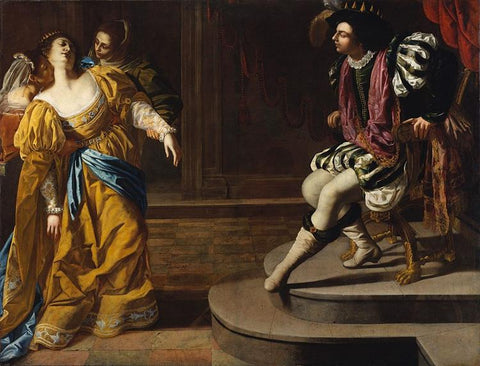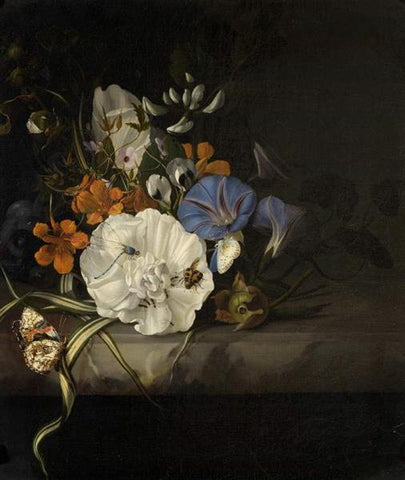In the spirit of Women's History Month, we turn our focus to the Baroque period, a time renowned for its dramatic expression, rich detail, and vibrant emotion in art. Amidst this era of artistic flourishing, several women artists broke through societal constraints to leave a lasting impact on the art world. Their contributions, spanning various facets of the Baroque style, not only showcase their exceptional talent but also their enduring strength in a predominantly male-dominated sphere. Join us in honoring the legacy and artistic beauty brought forth by these remarkable women.
Artemisia Gentileschi: A Trailblazer of Baroque Drama

Louise Moillon is a name that resonates with the warmth and vibrancy of the early French Baroque period, particularly through her masterful still-life compositions. Born into a family of artists in Paris in 1610, Moillon grew up in an environment that nurtured her artistic talents from a young age. Despite the societal constraints placed on women in the arts during the 17th century, she emerged as a leading figure in the still-life genre, celebrated for her distinctive approach to depicting market scenes and still lifes with a remarkable sense of realism and warmth.
"The Fruit and Vegetable Costermonger" (1631) is a prime example of Moillon's exceptional talent and her ability to breathe life into everyday scenes. This painting captures a moment of daily life with such fidelity that viewers can almost feel the textures of the fruit and vegetables and sense the atmosphere of the market. Moillon's technique in rendering the various surfaces—be it the softness of ripe fruit, the roughness of baskets, or the delicate petals of flowers—demonstrates her meticulous attention to detail and her deep understanding of texture and form.
What sets Moillon apart in the realm of still-life painting is not just her technical skill but also the warmth and humanity she infuses into her work. Her market scenes are imbued with a sense of quiet dignity and the simple beauty of the mundane. Through her careful composition and the subtle interplay of light and shadow, Moillon invites viewers to appreciate the beauty in everyday life, a theme that resonates with the Baroque tradition's emphasis on realism and emotional depth.
Moreover, Moillon's use of color is both vibrant and nuanced, capturing the natural hues of her subjects with a fidelity that was ahead of her time. Her ability to juxtapose colors and textures adds a dynamic quality to her compositions, making them not only visually appealing but also rich in symbolism. The abundance and variety of food in her paintings reflect themes of prosperity and the bountifulness of nature, common motifs in Baroque art that Moillon explored through the lens of her unique perspective.
"The Fruit and Vegetable Costermonger" and similar works by Moillon also offer a glimpse into the social and economic fabric of 17th-century France, highlighting the importance of market culture and the everyday lives of ordinary people. In this way, her paintings transcend their immediate appeal as still lifes, serving as historical documents that capture the essence of her era.
Judith Leyster: Capturing Joy in the Everyday

Two Musicians by Judith Leyster 1629
Elisabetta Sirani, a prominent figure in the Baroque art movement of the 17th century, emerged as one of the most productive and innovative female artists of her time. Born in Bologna in 1638, into a family deeply entrenched in the arts, Sirani quickly developed her distinctive style, characterized by dynamic compositions, a refined use of color, and an exceptional ability to convey emotion and texture. Her "Portrait of Vincenzo Ferdinando Ranuzzi as Amor" (1663) stands as a testament to her mastery and creative prowess, showcasing her unique contribution to the Baroque tradition.
This particular portrait is remarkable for several reasons, not least its subject matter and execution. Depicting Vincenzo Ferdinando Ranuzzi, a member of the Bolognese nobility, as Amor (the Roman god of love, commonly known as Cupid), Sirani ventures into the realm of allegorical portraiture, a genre that allows for greater expressive freedom and creativity. The choice to portray Ranuzzi as Amor is both a flattering homage and a clever use of iconography, imbuing the work with layers of meaning and a playful spirit that is characteristic of Sirani's approach to portraiture.
Sirani's skill in rendering textures is particularly evident in this work. The softness of Amor's flesh, the delicate feathers, and the luxurious fabrics that drape and fold around the figure are all depicted with meticulous attention to detail, demonstrating Sirani's keen observation and technical ability. Her use of light and shadow not only adds depth and volume to the figure but also highlights the texture of the materials, from the gleaming sheen of silk to the matte finish of the skin.
The composition of the portrait is dynamic and engaging, with Amor's gaze and the gesture of drawing an arrow from the quiver inviting the viewer into the narrative. This sense of movement and immediacy is a hallmark of the Baroque style, which sought to engage the viewer's senses and emotions. Sirani's ability to infuse her compositions with vitality and emotion speaks to her mastery of the Baroque language of art.
Moreover, Sirani's use of color in this portrait is both vibrant and harmonious, with the rich tones of the clothing and background setting off the paler hues of the skin. This careful balancing of colors not only enhances the visual appeal of the work but also contributes to its emotional resonance, with the warmth of the palette inviting a sense of intimacy and affection.
Maria Sibylla Merian: A Fusion of Art and Science

Maria Sibylla Merian, born in 1647 in Frankfurt, Germany, was an artist and naturalist whose work profoundly impacted both the art and science of her time. Her journey into the world of entomology and botany, culminating in works such as "From Metamorphosis insectorum Surinamensium, Plate XIII. (Spondias purpurea)" (1705), showcases a unique blend of scientific inquiry and artistic beauty, embodying the Baroque era's fascination with the natural world.
Merian's work is distinguished by its meticulous attention to detail and its commitment to accuracy, which was revolutionary for the period. At a time when the study of natural history was still in its infancy, and the depiction of flora and fauna was often based on hearsay and speculation, Merian's illustrations stood out for their reliance on direct observation. Her approach was both methodical and innovative; she spent years observing the life cycles of insects, documenting their metamorphoses with an artist's eye for detail and a scientist's demand for precision.
"From Metamorphosis insectorum Surinamensium, Plate XIII. (Spondias purpurea)" is a prime example of Merian's ability to capture the intricate beauty of nature. This particular plate depicts the Spondias purpurea, commonly known as the purple mombin or Spanish plum, accompanied by various stages of a specific insect's life cycle. What sets Merian's work apart is not just the accuracy of her depictions but also the way she arranges the elements on the page, creating compositions that are as aesthetically pleasing as they are informative. Her illustrations are characterized by vibrant colors, dynamic arrangements, and a keen sense of the textures and forms of her subjects, bringing the static page to life.
Merian's contributions to the natural sciences were groundbreaking. By illustrating the life cycles of insects alongside their host plants, she provided early evidence of ecological relationships, challenging the prevailing notions of her time. Her work in Suriname, where she traveled at the age of 52, was particularly significant. There, she studied and documented the indigenous flora and fauna, producing illustrations that would later be compiled into her magnum opus, "Metamorphosis insectorum Surinamensium." This work not only expanded European knowledge of the New World's natural history but also demonstrated the importance of illustration in scientific documentation.
Beyond her scientific achievements, Merian's work is celebrated for its artistic merit. Her illustrations reflect the Baroque era's interest in detail, complexity, and the interplay of light and shadow, yet they transcend mere representation. Through her art, Merian communicated her deep reverence for the natural world, inviting viewers to share in her sense of wonder and discovery.
Rachel Ruysch: The Floral Still-Life Maestro

Spray of Flowers with Insects and Butterflies on a Marble Slab
by Rachel Ruysch 1690
Rachel Ruysch, born in 1664 in The Hague, Netherlands, emerged as one of the most renowned floral still-life painters of the late Baroque period. Her work, characterized by its extraordinary detail, vibrant life, and intricate compositions, reflects a deep engagement with the natural world. "Spray of Flowers with Insects and Butterflies on a Marble Slab" (1690) is a quintessential example of Ruysch's mastery, showcasing not only her technical skill but also her unique ability to imbue static compositions with dynamism and emotional depth.
Ruysch's paintings stand out for several reasons, chief among them her meticulous attention to detail. Each petal, stem, and leaf in "Spray of Flowers with Insects and Butterflies on a Marble Slab" is rendered with precision, capturing the unique textures and colors of the individual elements. This precision extends to the depiction of insects and butterflies, each portrayed with scientific accuracy but also artistic flair, adding a layer of vitality to the composition. The inclusion of these creatures is not merely decorative; it reflects Ruysch's keen observation of nature and her understanding of the ecological interactions within it.
Another hallmark of Ruysch's work is her use of light and shadow, which adds depth and volume to her compositions. In this painting, the light seems to filter through the arrangement, highlighting the dew on the petals and the translucency of the wings of the butterflies. This interplay of light and shadow not only enhances the realism of the scene but also contributes to its emotional impact, inviting viewers to pause and contemplate the beauty and fragility of life.
The composition of "Spray of Flowers with Insects and Butterflies on a Marble Slab" is also noteworthy. Ruysch's arrangements are never haphazard; they are carefully constructed to guide the viewer's eye through the painting, creating a sense of movement and balance. The choice of a marble slab as the base for the arrangement adds an element of elegance and permanence, contrasting with the ephemeral nature of the flowers and insects. This juxtaposition is a subtle reminder of the transience of beauty and life, a theme often explored in Baroque art.
Ruysch's ability to convey the beauty and complexity of the natural world made her one of the most sought-after artists of her time. Her works were collected by royalty and nobility across Europe, attesting to her reputation and the high regard in which her art was held. Beyond her immediate success, Ruysch's paintings have had a lasting impact on the genre of still-life painting, influencing generations of artists with her innovative techniques and her passionate depiction of nature.
In "Spray of Flowers with Insects and Butterflies on a Marble Slab," as in all her works, Rachel Ruysch transcends the boundaries between art and nature, between observation and expression. Her paintings are not just representations of the natural world; they are celebrations of its diversity, beauty, and wonder. Through her unparalleled skill and her deep love for her subjects, Ruysch has secured her place as one of the leading artists of the Baroque period and a pivotal figure in the history of still-life painting.




